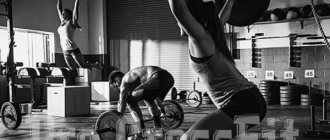Injuries in bodybuilding are quite common. This is explained by the fact that “iron sports” involves working with weights, often significantly exceeding the athlete’s own weight, which increases the load on the ligaments, joints and tendons. Working with heavy weights at the limit of your capabilities often leads to sprains, dislocations and even fractures. Where there is a high degree of risk, the importance of knowing safety precautions, or at least knowledge of a competent approach to working with weights, is also high.
Introduction
Almost every sport carries the potential for injury, and bodybuilding is no exception. In this sport, this likelihood is especially high, since you are constantly working with weights. To protect yourself as much as possible from injury, you should always warm up your muscles well at the beginning of your workout, thereby preparing them for the work ahead. Do warm-up, stretching, warm up on cardio equipment. It is also necessary to strictly adhere to the technique of correctly performing the exercises. If your technique is poor, you are more likely to get injured, especially when the weight on the bar is particularly heavy. It is advisable to train with a partner who can assist you in the process of performing exercises with significant weight. By the final repetitions, your strength will almost dry up, and in a situation where you are unable to hold a lot of weight, a training partner will come in handy and will provide backup at the right time.
ADVICE. Quite a lot of material on the topic of preparing the body for training, performing the main part of it and completing it competently is described in the article “On the importance and benefits of warming up, stretching and cooling down.” What role does warm-up play in the training process, why is stretching needed and how to perform it consistently for all muscle groups, for what purpose is work done on cardio equipment. You will find a detailed answer to all these questions in the article.
ADVICE. You can familiarize yourself with the technique of performing exercises separately for each muscle group by clicking on the appropriate links below. Our website contains about 90 exercises for all muscle groups, each of which is accompanied by an illustration with a detailed description of the technique and tips for performing them correctly and safely. We strongly recommend that you adhere to the described technique and thereby protect yourself from injury.
Exercises for muscles: back, chest, legs, shoulders, biceps, triceps, abs.
Types of injuries in bodybuilding
In relation to this sport, types of injuries can be divided into two categories: minor injuries and severe ones.
Minor injuries in bodybuilding are often sprained muscles, ligaments or tendons, which is actually not that dangerous for health, but if this happens, the right choice would be to stop the activity and wait until the pain subsides. Then you need to consult a doctor for a thorough examination of the injury and its appropriate treatment. If you are negligent about your health and continue training, then this can only worsen your situation. In this situation, the likelihood of getting a chronic sprain increases, which in the future will not allow you to lift significant weights.
Severe injuries in bodybuilding are most often separations of muscles, ligaments, tendons and sometimes fractures. You can’t do without a doctor in such a situation. In this state of affairs, surgery will be necessary to stitch the injured area or apply a plaster cast. In the future, this also threatens that you will no longer be able to work with heavy weights, since the risk of re-injury to the same area will be quite high. Without undue modesty, this can be called a disability rather than just an injury. Severe injuries can also include hernias, slipped intervertebral discs, and more.
We all, of course, view sport from a health perspective. And to maintain it, you not only need to do it, you also need to protect yourself as much as possible during classes. Some people in the gym get injured due to a simple disregard for the rules of conduct in the gym. Some people immediately start working with heavy weights without warming up, others are childish and, trying to express themselves in front of an audience, take on more weight than they can handle, which leads them to injury. Still others come to the gym in jeans, flip-flops, or some other clothing that restricts movement, does not support the foot, and is simply not appropriate for this type of activity.
Approach your training wisely. Pay attention to warming up, stretching and warming up. Don’t show off in front of others, you won’t prove anything to them, and you can only make things worse for yourself.
Symptoms and causes
Diagnosing elbow pain can be challenging due to the complexity of the joint and its central location in the upper extremity. Diagnosing injuries requires an understanding of the anatomy of the elbow, which includes three joints, two sets of ligaments, four muscle groups, and three major nerves. The medical history should be aimed at identifying the location of symptoms and identifying those activities that cause pain to the patient. It is important to identify specific muscle-ligamentous structures that are at risk of overuse and can be damaged during excessive loads. Mechanical symptoms indicate intra-articular pathology, while neurological symptoms are characteristic of nerve compression.
Types of activities and possible stress injuries to the elbow
Bowling: tendinitis, radial tunnel syndrome
Boxing: Biceps Tendinitis
Football, basketball, wrestling: Olecranon bursitis
Golf: Radial Tunnel Syndrome
Gymnastics: Biceps and triceps tendonitis, Posterior dislocation, Posterior rotational instability
Tennis: Pronator syndrome, triceps tendinitis, stress-olecranon fracture, tennis elbow, radial tunnel syndrome, golfer's elbow, ulnar neuritis
Rowing: Radial Tunnel Syndrome
Skis: Ulnar neuritis
Swimming: Radial Tunnel Syndrome
Throwing: Pronator syndrome, olecranon impingement syndrome, olecranon stress fracture, collateral ligament sprain, golfer's elbow, ulnar neuritis
Weightlifting: Biceps and triceps tendinitis, anterior capsule strain, radial tunnel syndrome, ulnar neuritis.
The timing of symptoms can be helpful in identifying possible overuse injuries. The severity of symptoms must be correlated with a possible increase after exercise and the presence of regression at rest. It is important to determine the localization of pain and the presence of pain irradiation. Factors that reduce or increase symptoms should also be identified.
This is especially important for identifying neurological and mechanical symptoms. Weakness or numbness are key symptoms indicating the presence of peripheral nerve compression or cervical radiculopathy. Mechanical symptoms such as clicking during movement, locking during extension may indicate intra-articular pathologies
Causes of pain associated with excessive stress
Anterior Elbow: Biceps Tendinitis, Pronator Syndrome, Anterior Capsule Deformity
Posterior Elbow: Triceps Tendinitis, Olecranon Impingement, Olecranon Stress Fracture, Olecranon Bursitis
Lateral Elbow: Tennis Elbow, Radial Tunnel Syndrome Osteochondritis Dissecans Posterior Rotational Instability
Medial Elbow: Golfer's Elbow Ulnar Collateral Ligament Sprain Ulnar Neuritis
Causes of injury
The easiest way to injury is not following the proper technique for performing exercises while simultaneously lifting heavy weights. Also, you can easily get injured if you don’t follow the rules of conduct in the gym. Always remove discs, dumbbells, barbells, handles and other equipment after you, as they can cause people to trip, fall and, consequently, get injured. Neglecting to use safety equipment, such as an athletic belt, wrist, knee and elbow bandages, can also lead to injury. Always use these tools when performing heavy exercises, or when working with heavy weights in any exercise, in order to protect yourself from injury. Unsuitable shoes can also cause injury during exercise. If your shoes do not support your feet, it can lead to muscle strains or joint injuries. Working without insurance, that is, without a partner, can also lead to injury if the weight of the projectile is large enough. When working in strength mode until your muscles fail, having a spotter is extremely necessary for you, otherwise it will not be difficult to get injured.
ADVICE. We directly talked about the importance of following the rules of behavior in the gym in the article “Preparing for your first visit to the fitness club.” In it, we described what you need to know before starting classes at a sports institution. We paid special attention to the importance of wearing equipment, and also described in some detail the etiquette of behavior, which we strongly recommend that literally everyone familiarize themselves with, regardless of your training experience.
ADVICE. You can read about sports equipment, its purpose and functions in our article “Purpose of sports equipment”. From it you will learn what an arm blaster is, the difference between athletic and gymnastics straps, the difference between gloves, palms and wrist hooks, and the difference between sneakers and weightlifting bars. In total you will find 18 pieces of sports equipment with their descriptions and purposes.
Injury Prevention
First, never neglect warming up, stretching, and warming up at the beginning of your workout. Secondly, always work on your exercise technique, try to always stick to it and don’t chase heavy weights. Always clean up equipment after yourself and do not throw discs from the barbell around the room. When working with a barbell, do not forget to put on locks. Use a belt, belt, elastic bands, bandages, straps and hooks during training. Wear only shoes that support your feet. Only sports shoes: sneakers or sneakers, but in no case flip-flops or slippers, which can be seen quite often in gyms. If possible, always try to ensure that you have someone to insure you. Try to find yourself a training partner, it will be easier for both you and him. Together you will insure, motivate and help each other during the training process.
ADVICE. When talking about what you shouldn’t throw around the room, you must first understand what we are talking about. We have already talked about elastic bands, bandages, straps and hooks above, but we have not yet talked about what is most often thrown underfoot and what creates a real problem of injury. Of course, we are talking specifically about barbells, bars, discs and locks. You can find a complete list of working equipment in the article “Description of free weights”. Also, you should not scatter “Handles and handles for pulls” and other “Sports equipment” around the hall.
Injuries in bodybuilding are one of the athlete’s worst and merciless enemies. Not only will they say “STOP” to your workouts, but they will also set your progress back a few steps. Having once received an injury, you will then remember it constantly, since it will make itself felt to you for a long time.
Since athletes lift serious weights during training, safety precautions in the gym must be at their best. As a rule, due to non-compliance, a lot of trouble arises not only for athletes, but also for those who own this gym. Injuries arise in most cases from the desire to surprise your friends and comrades. And it doesn’t matter what, it could be an unrealistic weight, or an intricate technique. The result is usually the same - injury, dislocation or sprain. Gyms produce record holders, but you need to approach record weights carefully, following all possible safety measures. Warm-up Preparing muscles for stress is the basics of any sport. Including bodybuilding, well-warmed muscles take the load much easier. Preparation can be divided into two stages, preliminary warming up of all muscles and warming up a separate group immediately before performing the exercise itself. Pre-warming occurs during the warm-up before training, and in order to prepare a specific muscle group, you should do the first approach to the exercise with a light weight. Implementing these steps will not take you much time, but will help you avoid injury. Below we look at the most common types of injuries. Neck According to statistics, the number of neck injuries in bodybuilding is many times greater than the number of lower back injuries. Here is a list of exercises in which the neck is most often injured: bent-over raises (with dumbbells and on blocks), seated bent-over raises, bent-over barbell rows (including the Smith variation), T-bar rows, bent-over dumbbell rows , hyperextensions, push-ups, bent-over arm extensions (from dumbbells or on a block), concentrated biceps curls, deadlifts, bent-over calf raises, lying leg curls. The main cause of neck injuries in these movements is the involuntary lifting of the head upward due to the desire to look at one’s reflection in the mirror. Back Very often from people whose activities involve lifting weights and not only, one hears things like, for example, “the lower back was torn,” “the back was pinched,” or simply “the back hurts.” Naturally, this does not happen by accident - as a rule, these are injuries caused by improper actions in lifting something heavy, although in some cases simply a careless movement is enough. Changes in the structural and functional parameters of tissues may also occur, which can be both a consequence of mechanical disorders and their cause. Along with this, a predisposition to injury is very often caused by imbalances in muscle development and changes in the natural deflections of the spinal column. Sometimes gravity acts on the spine at an angle. In this case, dislocations of the vertebrae and sprains of ligaments and tendons may occur. Insufficient recovery after heavy training can lead to the development of a herniated disc. In this case, the annulus fibrosus ruptures and the nucleus pulposus is released. Prevention of such injuries is a sufficient recovery period between workouts, which allows the tissue of the fibrous ring to fully restore its elasticity. The most common type of spinal injury is injury to the lumbar region, which is accompanied by a separation of the transverse process of the first lumbar vertebra. Such injuries are usually caused by heavy barbell exercises. Shoulders Alas, nature let us down. Deep in the shoulder joints there are small muscles that work exclusively on biomechanics. They are not designed for heavy bench and standing presses. Their potential for strength growth is minimal. The ligaments of these muscles are easily injured. In addition, during exercise these muscles rub against the bony process of the scapula. This is where unbearable pain and inflammation comes from. Many experienced bodybuilders live with analgesics for years. Among all joint injuries, including the shoulder, injuries received due to improper exercise technique stand out - this type of injury predominates. Shoulder injuries also occur if an athlete does not properly develop a training program. About a fifth of all injuries occur due to safety violations during training. It is necessary to carefully check your equipment before strength exercises. When lifting heavy weights, the athlete must be well prepared and adapted. Working with heavy weights without systematic training can result in muscle ruptures, tendon strains, and even bone fractures. During the studies, some athletes were diagnosed with ruptures of the supraspinatus tendon, although they never complained of pain. Another cause of shoulder pain is due to an imbalance in the distribution of muscle tendons around the joint capsule. Spasms, overexertion or, conversely, insufficient tension of one or more muscles can lead to the fact that the shoulder joint is in a dangerous position. Equipment Weightlifting Belt Most people who start working out in the gym think that a weightlifting belt protects the lower back by putting pressure on the back muscles. In reality this is not entirely true. First, the belt protects the abdominal muscles from stretching and the risk of hernia when lifting heavy weights. Secondly, compression of the abdominal cavity increases intra-abdominal pressure, which, as it were, props up the back muscles from the inside. Elastic bandages Bandages are the second main element of equipment used in the pre-competition cycle of a weightlifter. The athlete should be bandaged tightly, but not so tightly that they require two people to help them stand and carry them to the platform. Wrap your wrists in bandages. During many exercises, a huge load is placed on the wrists. Finally, some general advice. Watch the weight of the barbell if you train alone. The bench press with heavy weights is dangerous to perform without a belay partner. You also need to gradually increase the training weights, and not try to lift unliftable barbells overloaded with weights. It is not quantity that matters, but quality. Control the speed of the exercise and breathing. No sudden jerks, only smooth lifting and lowering of the weight, otherwise there will be serious problems with ligaments and joints. Make sure the plates are secured to the bar. I think it's not hard to imagine what might happen otherwise.
Don't get distracted during your approaches and don't distract others. Otherwise, the whole approach may go down the drain. In addition, safety precautions are grossly violated.
Stay focused and nothing will stop your muscle growth.










